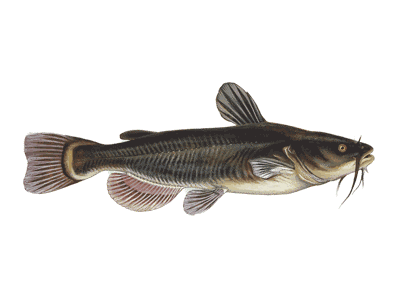Several species of bullhead catfish are found throughout North America, with 3 species being well known. Bullheads are usually small with a 3-pound specimen being an exceptional fish.
Often thought of as scavengers, bullhead catfish are actually highly evolved predators with barbells that serve as sensory organs. They are easy to distinguish from non-bullhead catfish due to their squared tail and small but stocky build.
Black bullheads are usually black, dark olive, or dark brown on the back. Their belly is greenish-white or yellowish. They have dark chin barbels and lack mottled markings on their sides.
Brown bullheads are generally dark brown above with yellow to white bellies. They have mottled sides and light margins on their fins. These small catfish have broad, flat heads and dark chin barbels. Brown bullheads average about eight to 14 inches in length. Their square tail and mottled side coloration distinguish it from other bullheads.
Yellow bullhead can be distinguished from brown bullheads by their white chin barbels and rounded rather than square tail. Yellow bullheads are found in ponds, streams, and small brooks, preferring areas of vegetation and clear water. Yellow bullheads tend to be somewhat smaller (eight to 12 inches) and heavier built than brown bullheads. The world record for this species is a 6-pound, 6-ounce fish caught in Missouri in 2006.
Depending on the region, bullheads may be referred by a variety of common names including bullhead catfish, bullheads, mud cats, pollywogs, pollies, river catfish, horn pout and others.
Bullhead catfish prefer slow moving or still waterways but will tolerate a variety of habitats, including muddy water and low oxygen levels. They rely primarily on sense of smell to find food.
Bullhead catfish can be caught with the same techniques that are commonly used for other catfish. They are easily enticed with worms, hellgrammites, stink baits or cut baits fished on the bottom. According to Henry David Thoreau, “they will take any kind of bait, from angleworms to a piece of tomato can.” They make excellent table fare and are a good choice for anglers that enjoy freshwater fishing.
